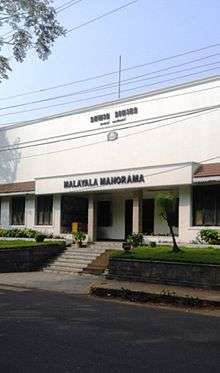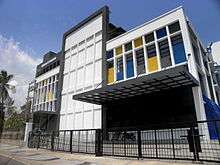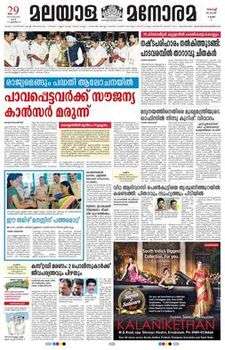Malayala Manorama
|
| |
|
The Most Read Newspaper in Malayalam. | |
| Type | Daily newspaper |
|---|---|
| Format | Broadsheet |
| Owner(s) | Malayala Manorama Company Limited |
| Founder(s) | Kandathil Varghese Mappillai |
| Publisher | Jacob Mathew |
| Editor-in-chief | Mammen Mathew |
| Managing editors | Philip Mathew |
| Founded | 1888 |
| Political alignment | Centre-right |
| Language | Malayalam |
| Ceased publication | 1938 |
| Relaunched | 1947 |
| Headquarters | Kottayam (Kerala) |
| Circulation | 2,342,747 Daily[1] (as of Jul - Dec 2015) |
| Website |
www |

Malayala Manorama (Malayalam: മലയാള മനോരമ) is a daily morning newspaper, in Malayalam language, published from Kottayam in the state of Kerala, India by Malayala Manorama Company Limited. It was first published as a weekly on 22 March 1890, and currently has a readership of over 20 million (with a circulation base of over 2.1 million copies).[2][3] The Malayalam title "Manorama" roughly translates to "entertainer".
According to World Association of Newspapers, as of 2011, it holds a position as the fifth most circulating newspaper in the world. According to the Audit Bureau of Circulations (ABC) 2013 figures, it is the third largest circulating newspapers in India (behind The Times of India and Dainik Jagran) and largest circulating newspaper in Kerala.[4]
History
The Malayala Manorama Company is a private LLC corporation owned by the Kandathil family of Kottayam.[5] Malayala Manorama Company was incorporated by Kandathil Varghese Mappillai at Kottayam on 14 March 1888. The company started with one hundred shares of Rs 100 each. The investors paid in four equal instalments. With the first instalment, the company brought a Hopkinson and Cope press, made in London. A local craftsman, Konthi Achari, was hired to make Malayalam types for the imported press.
Mappillai had worked for a year as editor of Kerala Mitram, a Malayalam newspaper run by Gujarati businessman Devji Bhimji, in Cochin. The maharajah of Travancore Moolam Thirunal approved the logo of the newspaper which was a slight modification of the Travancore Coat of Arms, which is now used by the Government of Kerala with slight modifications.[6]
First issue of Malayala Manorama published on 22 March 1890 from M.D Seminary Kottayam, while Kottayam was hosting a popular cattle fair. It was a four-page weekly newspaper, published on Saturdays. The weekly newspaper became a bi-weekly in 1901, a tri-weekly on 2 July 1918 and daily on 2 July 1928.[7] In 1938, Travancore state proscribed Malayala Manorama daily. Later editor K. C. Mammen Mappillai was convicted and imprisoned on charges of corruption and fraud. Malayala Manorama re-commenced regular publication in 1947.
On K.C. Mammen Mappilla's death, his eldest son K.M. Cheriyan took over as the Editor-in-Chief in 1954. Malayala Manorama was produced in a single edition in the central Kerala town of Kottayam with a circulation of 28,666 copies.[8]
However, by the late 1950s, Manorama steadily increased circulation and overtook Mathrubhumi in circulation, the dominant Malayalam daily at the time.
Expansion to entire Kerala (1960s)
The struggle between Malayala Manorama (Kottayam) and Mathrubhumi (Calicut) demonstrated the forces that would drive the expansion of Indian regional newspapers. The contest also illustrated the difficulties if expansion had to rely on Gutenberg-style printing as with the case of Manorama.[9]
Comparison of circulation Malayala Manorama and Mathrubhumi (from India's Newspaper Revolution (2000) by Robin Jeffrey, Western Influence on Malayalam Language and Literature (1972) by K. M. George and Audit Bureau of Circulations (ABC) 2013)
- Mathrubhumi
- Manorama
In 1962, Mathrubhoomi launched its second edition in Kochi. The new edition sent Mathrubumi to a circulation of 170,000 copies by 1964, 19,000 more than its rival, Malayala Manorama. With Mathrubhoomis circulation rising, it became a compulsion for Manorama to expand its reach, and consequently, introduce new technology. The competition set off a keen struggle for more readers, faster equipment and national advertising from major consumer goods companies [such as Hindustan Lever].[8] Manorama launched its printing centre at Calicut, Malabar in 1966 with a cast-off press from the paper's base at Kottayam and hand-composed type.[10] But in the run-up to that event, it had installed an offset press at Kottayam and established a teleprinter line with New Delhi in 1965.
By 1970, it was the leading daily in Kerala. The circulation of the newspaper rose from around 30,000 to 300,000 by this expansion to Malabar.[7][11]
1980s
K. M. Mathew, who took charge as editor in 1973, began a series of renovations, just as the Anandabazar Patrika did Bengal. He brought in a series of consultants in the management [1979], technical and editorial areas, and accepted their guidance. He conducted frequent training sessions for Manorama journalists and other employees. The company restructured their organisation in 1980.[12] KM Mathew said that the decision stemmed from the realisation that the daily had either to become "fully professional" or "risk decline". Mathew sent his best journalists and managers to training schools around the world, and imported the most effective techniques in international journalism and newspaper production, which brought in a contemporary look and feel to Malayala Manorama.[8] In 1979, a new printing centre was launched at Cochin and in 1987, the Trivandrum edition was also launched. By 1998, the circulation of Malayala Manorama was increased to 1 million. In mid-2000s, the daily started units in the Middle East, focusing on the large Malayalee population in the region. Mathew is credited with the introduction of the concept of "editionalising" with larger share for local news and reader-friendly packaging through professional page designing in Manorama, which in turn impacted the entire newspaper industry in Kerala. By 2007, Manorama become the only regional language daily [non-English/non-Hindi] in India to cross 1. 5 million copies in circulation.[13][14]
K. M. Mathew was succeeded by his son Mammen Mathew in 2010. "In what could only be described as a rarity then in Indian language journalism, Mathew showed an unusual commitment to modernisation and professionalism and became a role model for the newspaper industry, which in the early 1980s was at the critical juncture of embarking on a phase of unbelievable expansion." The Hindu praised KM Mathew in their obituary.[8]
As per ABC January–June 2013 figures, Malayala Manorama holds a circulation of 2.1 million readers.[15]
Chief Editors
- Kandathil Varghese Mappillai (1890 - 1904)
- K. C. Mammen Mappillai (1904 - 1938, 1947 - 1954)
- K. M. Cherian (1954 - 1973)
- K. M. Mathew (1973 - 2010)
- Mammen Mathew (2010–present)
Printing centres

- Kottayam, Kozhikode, Thiruvananthapuram, Kochi, Thrissur, Kannur, Kollam, Palakkad, Malappuram, Pathanamthitta, Alappuzha, Mangalore, Bangalore, Chennai, Mumbai, Delhi, Dubai, Manama and Doha
Subsidiaries

| Name | Frequency | Language | Type |
|---|---|---|---|
| Arogyam | Monthly | Malayalam | Health |
| Balarama | Weekly | Malayalam | Comic magazine |
| Balarama Amar Chitra Katha | Fortnightly | Malayalam | Comics |
| Balarama Digest | Weekly | Malayalam | Children |
| Bhashaposhini | Monthly | Malayalam | Arts and literature |
| Kalikkudukka | Weekly | Malayalam | Children |
| Karshakasree | Monthly | Malayalam | Agriculture |
| FastTrack | Monthly | Malayalam | Automobile |
| Magic Pot | Weekly | English | Children |
| The Man | Monthly | English | Men's lifestyle |
| Manorama Weekly | Weekly | Malayalam | General interest |
| Sampadhyam | Monthly | Malayalam | Market |
| Smart Life | Monthly | English | Society |
| Tell Me Why | Monthly | English | Children |
| Thozhil Veedhi | Weekly | Malayalam | Career |
| Traveller | Monthly | Malayalam | Travel |
| Vanita | Fortnightly | Hindi | Women |
| Vanitha | Fortnightly | Malayalam | Women |
| Vanitha Veedu | Monthly | Malayalam | Property |
| Watch Time India | Monthly | English | Technology |
| The Week | Weekly | English | News and general interest |
See also
References
- ↑ "Submission of circulation figures for the audit period July - December 2015" (PDF). Audit Bureau of Circulations. Retrieved 5 January 2016.
- ↑ International Federation of Audit Bureaux of Circulations and ABC India (National Newspapers Total Circulation-2010) Download
- ↑ Audit Bureau of Circulations (ABC) (January-June 2013)
- ↑ Sangeeta Tanwar. IRS 2010 (Q1) afaqs! Dailies in Kerala lose readers after gaining in the last round
- ↑ Robin Jeffrey. India's Newspaper Revolution: Capitalism, Politics and the Indian-language Press, 1977-99 C. Hurst & Co. Publishers, 2000
- ↑ Manorama Online (About Us) Slideshow
- 1 2 Manorama Online (About Us) Page 1
- 1 2 3 4 R Krishnakumar OBITUARY: Mathew touch. The Hindu Vol: 27 Iss: 17
- ↑ Robin Jeffrey. India's Newspaper Revolution: Capitalism, Politics and the Indian-language Press, 1977-99 C. Hurst & Co. Publishers, 2000 pp. 81
- ↑ Robin Jeffrey. India's Newspaper Revolution: Capitalism, Politics and the Indian-language Press, 1977-99 C. Hurst & Co. Publishers, 2000 pp. 82
- ↑ Robin Jeffrey. India's Newspaper Revolution: Capitalism, Politics and the Indian-language Press, 1977-99 C. Hurst & Co. Publishers, 2000 pp. 94
- ↑ Robin Jeffrey. India's Newspaper Revolution: Capitalism, Politics and the Indian-language Press, 1977-99 C. Hurst & Co. Publishers, 2000 pp. 67
- ↑ Robin Jeffrey. India's Newspaper Revolution: Capitalism, Politics and the Indian-language Press, 1977-99 C. Hurst & Co. Publishers, 2000
- ↑ K.M. Mathew, doyen of Malayalam journalism. 1 August 2010 The Hindu
- ↑ Audit Bureau of Circulations (ABC) (January-June 2013)
External links
| Wikimedia Commons has media related to Malayala Manorama. |
